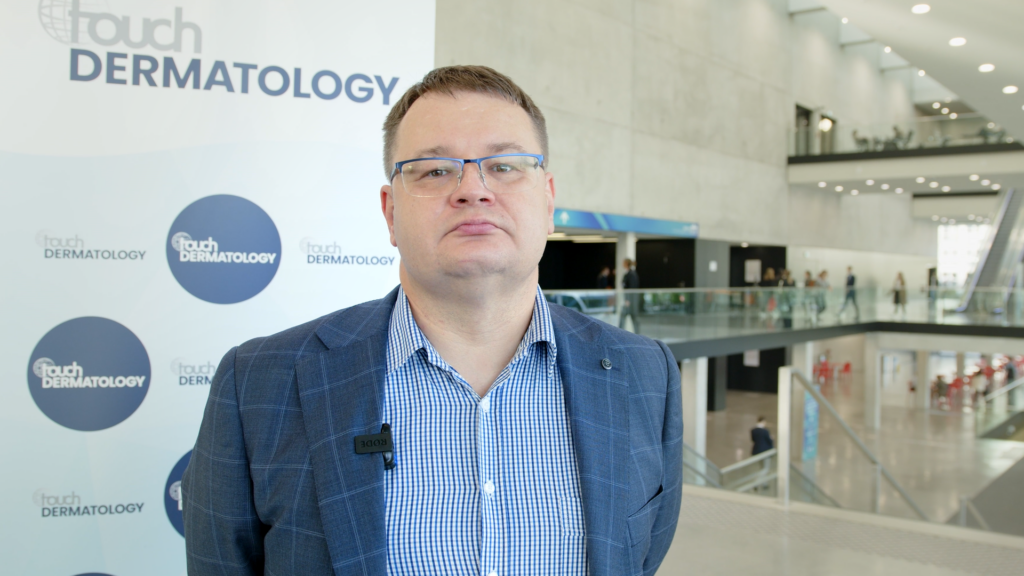At ASCO 2024 in Chicago, some exciting breakthroughs in melanoma research were revealed. Researchers from around the world presented innovative studies and cutting-edge treatments that could significantly impact melanoma care. We have selected some of the most exciting data to highlight that could impact patient outcomes in the future.
PIVOTAL trial shows promising results for daromun in locally advanced melanoma
Results from the PIVOTAL (NCT02938299) trial, an open-label, randomized, multicenter phase III study showed promising results for daromun as a neoadjuvant intralesional therapy for patients with resectable, locally advanced stage III melanoma. Daromun, which combines two antibody-cytokine fusions (L19IL2 and L19TNF), had previously demonstrated efficacy in treating unresectable melanoma.
Between July 2016 and August 2023, 127 patients were treated with Daromun, while 129 patients were assigned to the control arm. The primary endpoint of the study was relapse-free survival (RFS). Results showed a notable improvement in the treatment arm, with a hazard ratio (HR) of 0.59 according to the Blinded Independent Central Review (BICR) and 0.61 per investigator assessment. Median RFS for patients in the treatment arm was 16.7 months, compared to just 6.9 months for those in the control arm.
In addition to RFS, distant metastasis-free survival (DMFS) also saw significant improvement, with an HR of 0.60. The safety profile of Daromun was favorable, with predominantly low-grade adverse events reported; only 14% experienced grade 3 treatment-emergent adverse events (TEAEs).
Overall, the trial’s analysis of the primary efficacy endpoint RFS, along with secondary endpoints such as DMFS, pathological complete response (pCR), and safety, indicates that neoadjuvant Daromun is an effective and safe therapeutic option for patients with resectable, locally advanced melanoma.
Combi-AD trial update: Dabrafenib plus trametinib shows significant benefits for melanoma patients
The final results of the COMBI-AD trial (NCT01682083) have confirmed that the combination of dabrafenib and trametinib substantially improves outcomes for patients with BRAF-mutated AJCC-stage III melanoma. The updated data reveals a marked enhancement in relapse-free survival (RFS) and distant-metastasis-free survival (DMFS) for those receiving the adjuvant therapy.
With a median follow-up of 100 months for the treatment group and 82.5 months for the placebo group, the study found that median overall survival (OS) was not reached in either group. However, the hazard ratio (HR) of 0.80 (P=0.063) indicates consistent OS benefits across most subgroups. Notably, the RFS (HR: 0.52) and DMFS (HR: 0.56) significantly favoured the treatment arm.
The safety profile of dabrafenib plus trametinib was in-line with previous reports, maintaining its known safety standards. This trial now provides the longest follow-up data—spanning over 10 years—in the adjuvant treatment of stage III melanoma, demonstrating a 20% reduction in the risk of death for patients receiving the therapy.
Results from NADINA highlight promising neoadjuvant immunotherapy for stage III melanoma
The phase III NADINA trial (NCT04949113), has demonstrated significant benefits of neoadjuvant immunotherapy for patients with resectable stage III melanoma. Building on previous phase II studies, the trial compared neoadjuvant (pre-surgery) and adjuvant (post-surgery) treatments.
From August 2021 to December 2023, 423 patients participated in the NADINA trial. By January 2024, with a median follow-up of 9.9 months, the neoadjuvant group experienced significantly fewer adverse events (28 vs. 72) and achieved higher 12-month EFS rates (83.7% vs. 57.2%) compared to the adjuvant group. However, systemic treatment-related adverse events of grade ≥3 were more common in the neoadjuvant group (29.7% vs. 14.7%).
These results suggest that neoadjuvant ipilimumab plus nivolumab, followed by response-driven adjuvant treatment, could become a new standard of care for stage III melanoma, offering improved event-free survival rates.
RELATIVITY-048 demonstrates positive results for immuno-oncology triplet in advanced melanoma
The RELATIVITY-048 (NCT03459222) trial showed promising results for the immuno-oncology combination of nivolumab, relatlimab and ipilimumab in advanced melanoma patients. This phase I/II study included 23 patients who had not previously received immune checkpoint inhibitor therapy, with a median follow-up of 44.1 months. Participants had a median age of 61, with notable characteristics including 8.7% with cutaneous acral melanoma, 50% BRAF positive, 73.9% LAG-3 positive and 26.1% PD-L1 positive. The median treatment duration was 5 months. The combination achieved an overall response rate of 58.7% and a 48-month overall survival rate of 69.1%. Treatment-related adverse events occurred in 95.7% of patients, with 39.1% experiencing severe grade 3/4 events, and there were two treatment-related deaths.
OV-COM-202 shows encouraging response rates in advanced melanoma
The OV-COM-202 (NCT03645928) Cohort 1A study has revealed promising outcomes for a new combination therapy in treating advanced melanoma patients who have not previously received immune checkpoint inhibitors (ICI). This combination involves lifileucel, an autologous tumor-infiltrating lymphocyte (TIL) therapy, and pembrolizumab, an established immunotherapy drug.
The study included patients with resectable lesions suitable for lifileucel manufacturing and measurable lesions for response assessment. The treatment regimen comprised initial pembrolizumab administration, followed by lymphodepletion, a single infusion of lifileucel, multiple doses of interleukin-2 (IL-2), and continued pembrolizumab until either disease progression or unacceptable toxicity levels were reached.
As of December 2023, 22 patients had undergone this treatment. The results are encouraging, with an objective response rate (ORR) of 63.6%. Impressively, 22.7% of the patients achieved a complete response, while 40.9% showed a partial response. Notably, the responses improved over time, with 71.4% of the patients maintaining ongoing responses.
However, the treatment was not without significant adverse events. The most common severe (grade ≥3) side effects included thrombocytopenia, neutropenia and anemia. Despite these challenges, the promising response rates warrant further investigation with recruitment into the ongoing phase III TILVANCE-301 trial (NCT05727904) underway.
Disclosures: This article was created by the touchDERMATOLOGY team utilizing AI as an editorial tool (ChatGPT (GPT-4o) [Large language model]. https://chat.openai.com/chat.) The content was developed and edited by human editors. No funding was received in the publication of this article.



